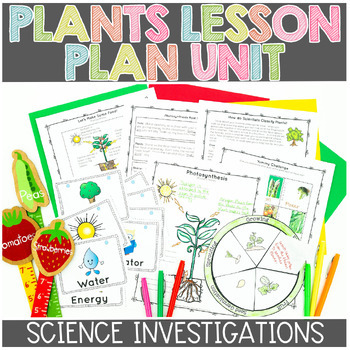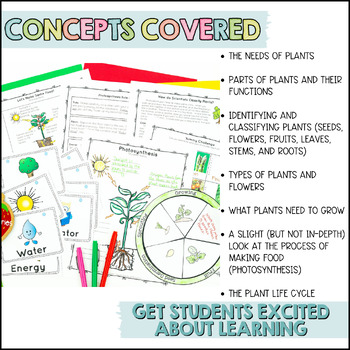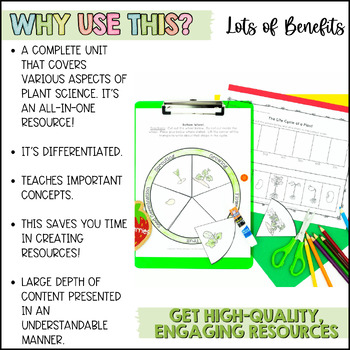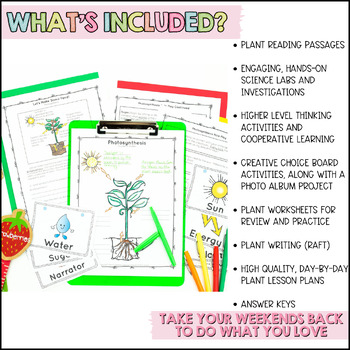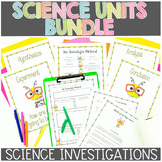Parts of a Plant, Plant Life Cycle, Plant Needs, Photosynthesis Lesson Plan Unit
- PDF
- Easel Activity
What educators are saying
Also included in
- When I named this bundle with the phrase "exploring everything," I meant it! This bundle provides you with a complete unit about plans that will take you from the beginning to the end of the unit with minimal work on your part. I've got it all created, planned out, and ready for you to teach!Save 20Price $10.88Original Price $17.00Save $6.12
- This ultimate science units bundle is designed to elevate your science lesson plans beyond the traditional methods and into a world of research-based, teacher-tested approach! These units cover all the essential concepts in depth with hands-on activities, experiments, inquiry-based activities, diffePrice $46.24Original Price $72.25Save $26.01
Description
Do you need to teach all about plants, but aren’t sure where to begin? This comprehensive plant unit has got you covered! From exploring the parts of plants and their functions to unraveling the mysteries of the basic needs of plants, this unit has it all! Watch your students blossom as they explore hands-on labs, engaging plant activities, cooperative learning, and so much more!
Try Before you Buy:
Free Pollination Demonstration. It's a free lesson from this unit!
Save at least 20% off when you purchase the bundle!
What Concepts & Skills are Covered?
- The needs of plants
- Parts of plants and their functions
- Identifying and classifying plants (seeds, flowers, fruits, leaves, stems, and roots)
- Types of plants and flowers
- What plants need to grow
- A slight (but not in-depth) look at the process of making food (photosynthesis)
- The plant life cycle
What’s Included?
- Plant reading passages
- Engaging, hands-on science labs and investigations
- Higher level thinking activities and cooperative learning
- Creative choice board activities, along with a photo album project
- Plant worksheets for review and practice
- Plant writing (RAFT)
- High quality, day-by-day plant lesson plans
- Answer keys
Why Grab This Resource?
- This resource offers a complete unit that covers various aspects of plant science, including the needs of plants, parts of plants and their function, the plant life cycle, and so much more. It’s an all-in-one resource!
- It helps with differentiation by catering to the diverse learning styles and needs, including options for enrichment and early finishers.
- It helps teach important concepts, allows for practice and review, and assess student understanding. This saves you time in creating resources!
- This resource has received positive feedback from other buyers, specifically mentioning its depth of content presented in an understandable manner.
This science unit on plants offers comprehensive, ready-to-use lessons, engaging activities, and interdisciplinary integration that will help you save time in lesson planning and allow you to confidently teach plant science with minimal stress! Try it today and start building essential skills in a fun and creative way!
More Resources to L❤️VE:
Plant's Structure and Functions Craftivity
Printing Notes:
While I recommend printing in color and laminating materials for future use, it is not necessary. These materials print just fine in grayscale. I would suggest printing "as image" to avoid any potential issues. Additionally, download the resource to your computer, open it, and then print. Printing from your browser often creates problems.
Having Difficulty with the File?
Contact TpT Tech Support for assistance or ask a question in the Q&A before leaving feedback.
☞Mistakes Happen!☜
If you see ANYTHING that needs modifying, or if you have any questions, please contact me via the Q&A. I take my product creation and your satisfaction very seriously! Thanks!
⭐Earn FREE Resources! ⭐
It's very important to me that you provide feedback so that I may improve and create products you will use and love! Please consider leaving detailed feedback. Additionally, each time you provide feedback, you earn TpT credits. These can be taken off purchases so you can get items for free!
❤️EXCLUSIVE FREEBIES ❤️
Follow my store here to get discounted goodies each time they're posted! Additionally, you'll receive my EXCLUSIVE note to followers which include EXCLUSIVE freebies and additional special deals.
Want to share with a teacher friend? Here's how:
In order to make it easy, and legal, for you to share with your teacher friends or team, you may purchase additional licenses of this product for additional discount off the original price. To do this, go to your "My Purchases" page and click on "Buy Additional Licenses." This is a great way to buy for an entire team or grade level while respecting the copyright licenses of the author. Thank you for being a responsible teacher buyer.

